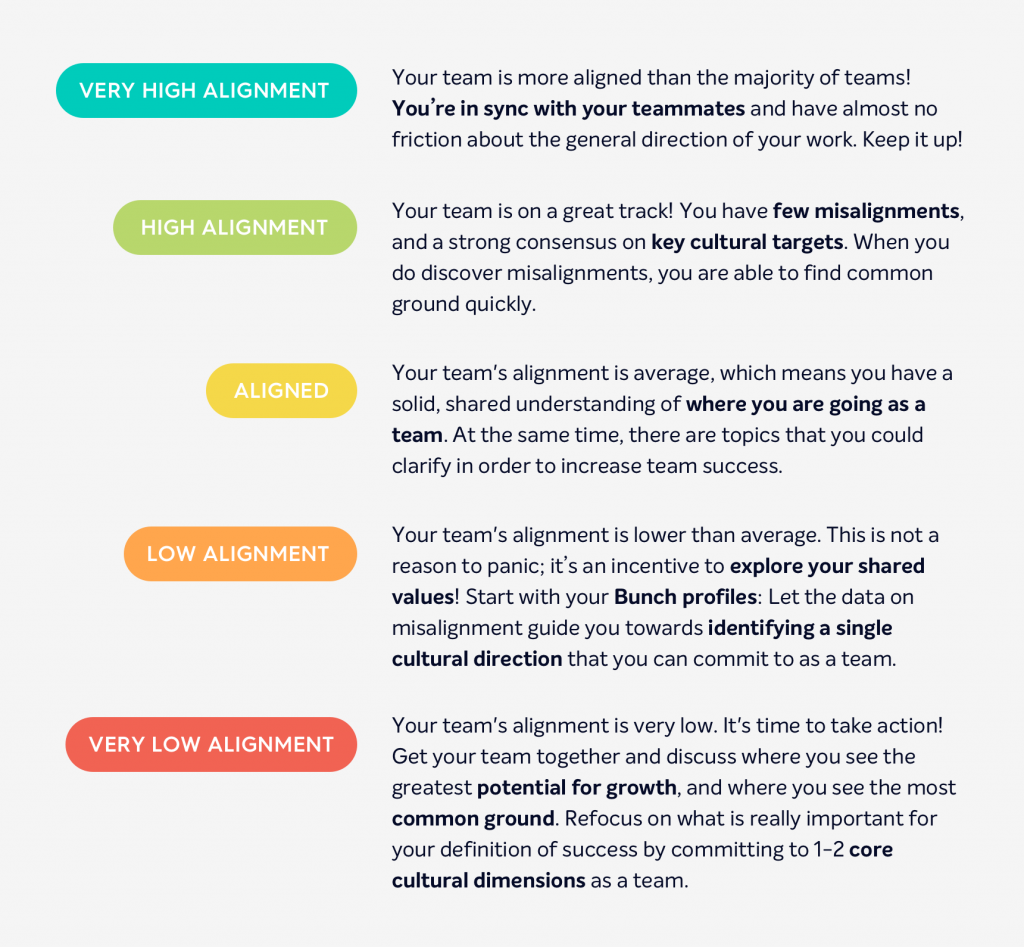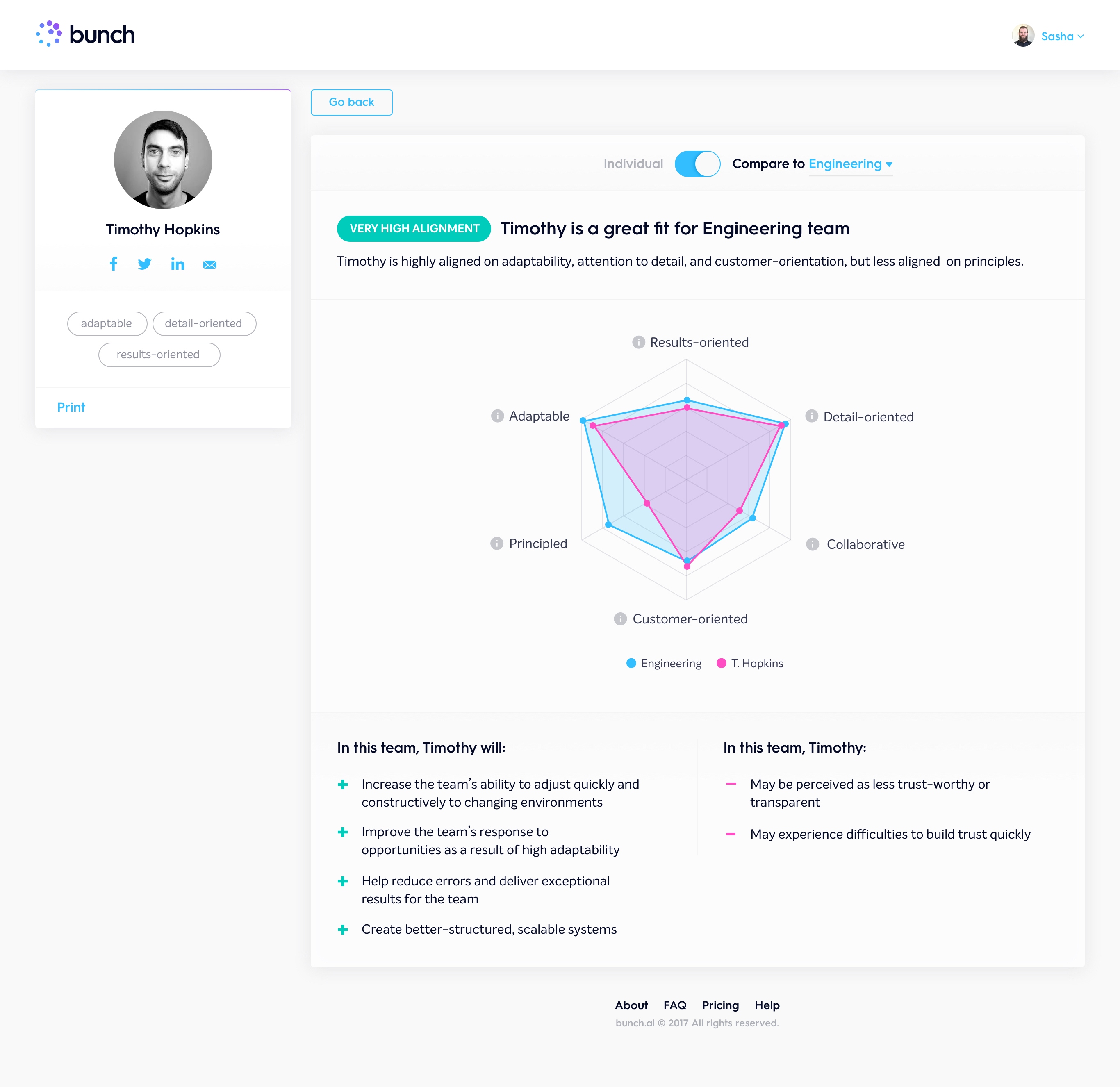The next time you login to your Bunch account, you will notice your team’s scores have changed. We’ve upgraded our scoring system and now it uses a completely different index that will help you measure and understand team culture more efficiently than before. We’re continuing to combine Stanford research with our growing data set to deliver more robust updates. This means the data you receive on the Bunch platform will be more personalized and more easily translated into positive culture changes.
After 2 months of listening to your feedback, here’s the lowdown on Bunch’s Culture Score 2.0!
What do I need to know?
How does this new score help me build better teams?
Actionable Scoring Categories: Instead of just a team alignment score percentage, you’ll now have the following 5 categories: Very High Alignment, High Alignment, Aligned, Low Alignment, Very Low Alignment. This means you get a more informative score as a baseline, which will help you make better, more confident hiring decisions.
Evolved Fit Score: Hiring for fit score has also been upgraded! When evaluating a candidate, you now have the opportunity to see both how much they align with your team, and how that translates to a positive or negative impact on your baseline. We do this by adding their score to the team, calculating the new alignment score, and measuring the difference between that score and the original team’s. If it’s a positive change, they’ll have a positive impact on the team and vice versa. This will be especially helpful when preparing for interviews and aligning team and candidate expectations.

For team members’ fit scores, we use the same logic as we do with candidates, but just the other way around: we take a team member out of the team, run the alignment score again and compare the two. If the team score goes down it tells you that this person is culturally valuable, and puts a number to that value.
Real-world context: This means your score is placed in the context of all the teams in our data set, meaning when you get a score of Very High Alignment, you know you’re in the top 10% of the teams that use Bunch! If you have High Alignment, you’re in the top 30%. If you’re Aligned, you’re in the top 70% If you have Low Alignment you’re in the bottom 30%. Finally, if you have Very Low Alignment, you’re in the bottom 10% of teams that use Bunch. This insight will become even more powerful as our data set continues to grow.

What exactly has changed?
The primary upgrade is our use of variance in our calculations. Variance is a fancy way of saying we’re taking the average of your team members’ scores on each dimension (adaptability, integrity, etc.) and then measuring how far each person is from that average (per dimension).
For example: consider the dimension of adaptability. If the scores of each of your team members are wildly different, that’s a sign you’re team is not aligned on this dimension. If the scores of each of your team members sit close together – which means they have a low variance – then you are more aligned on this dimension. Your overall team alignment score reflects how you do across the 6 dimensions. So maximum alignment comes when a team has low variance in score across all 6 dimensions.

This is a much more straight-forward way of figuring out how aligned your team is, and it will give you more quantifiable insights on your team. Why?
Not only is this method simpler to understand (because alignment is inversely related to variance) but it also gives us the ability to tailor scoring to the size of your team. This comes into play when classifying where your team alignment score falls on the Bunch alignment scale (see below, where we introduce the 5 new categories). What it takes to achieve a score of ‘Highly aligned’ will be different if you have a team of 3 or a team of 33 (for more on the technical side of things, check out this paper).
Let’s Wrap Up:
The score is naturally evolving and becoming more powerful (like your favorite Pokemon!) We’re really excited about this development, and about the new insights it will create! Please reach out to us and let us know your thoughts! You can find us on Twitter, LinkedIn, Facebook, or in the comments below!




